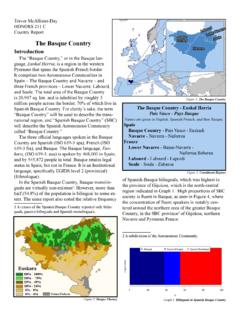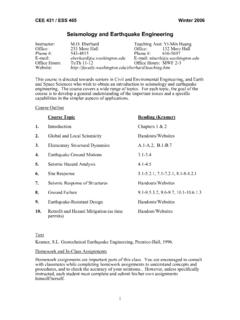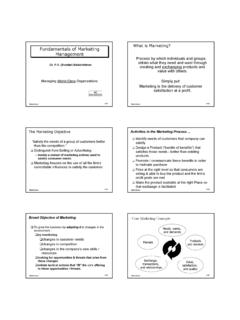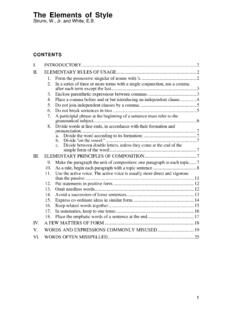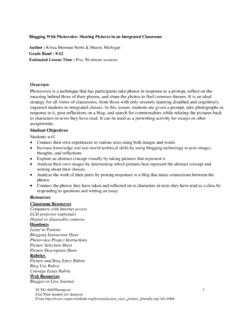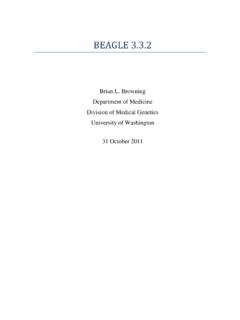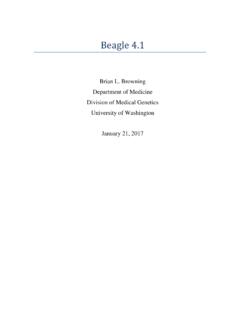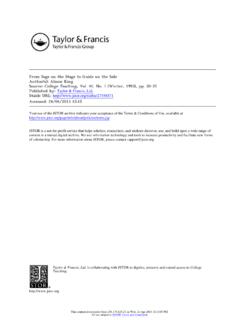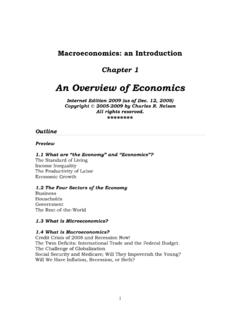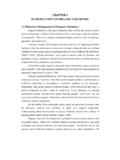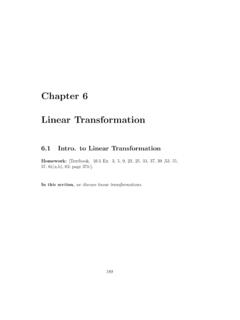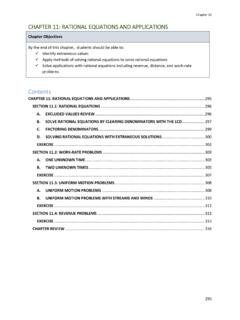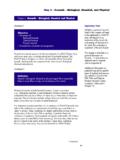Transcription of Chapter 8: The Logic of Conditionals
1 Copyright 2004, S. Marc Cohen Revised 6/1/04 8-1 Chapter 8: The Logic of Conditionals Informal methods of proof Conditional elimination This method of proof is also known by its Latin name, modus ponens (literally, method of affirming roughly, having affirmed the antecedent of a conditional, you may affirm the consequent). From P and P Q , you may infer Q. Biconditional elimination This is sometimes called modus ponens for the biconditional. From P and P Q , you may infer Q. From P and Q P , you may infer Q. Some handy equivalences Contraposition P Q Q P The conditional disjunction equivalence P Q P Q The negated conditional equivalence (P Q) P Q The biconditional conjunction equivalence P Q (P Q) (Q P) The biconditional disjunction equivalence P Q (P Q) ( P Q) In some systems of deduction for the propositional portion of FOL, these equivalences are used as rules. In the system F, and in Fitch, these are not going to be rules.
2 In fact, we will be using Fitch to prove these equivalences. Still, it is useful to be aware of them. Note that the equivalence symbol is not a connective of FOL, but a symbol we use in the metalanguage (in this case, English, the language in which we talk about FOL), and the statements of equivalence are not FOL sentences. For a useful chart of tautological equivalences, see the Supplementary Exercises page on the course web site. Look under the listings for Chapter 7. The method of conditional proof This very important method of proof is a way of establishing conditional sentences. In using this method, we make a provisional assumption, P, and deduce some consequences of it. When we arrive at some appropriate sentence, Q, we have shown that the assumption of P has led to the conclusion Q. We may then discharge the assumption of P and conclude that if P, then Q. Copyright 2004, S. Marc Cohen Revised 6/1/04 8-2 How do we know when we have reached an appropriate sentence, Q ?
3 We should know in advance which sentence we are looking for. Since we are trying to establish a conditional sentence, we assume its antecedent and attempt to deduce its consequent. Note that the method of conditional proof can be used for biconditionals, too. To prove P Q, construct separate conditional proofs for each of the Conditionals P Q and Q P. The conjunction of these two Conditionals is equivalent to the biconditional P Q. (See the biconditional conjunction equivalence above.) Formal rules of proof for and Conditional elimination ( Elim) P Q P Q That is, if you have a conditional on one line in a proof, and its antecedent (alone) on another line, you may infer the consequent. As justification, you cite the two earlier lines. Conditional introduction ( intro ) P Q P Q This is the formal counterpart of the method of conditional proof. Begin a subproof with P, the antecedent of your desired conditional.
4 When your desired consequent, Q, occurs on a later line in the subproof, end the subproof and enter the conditional P Q. As justification for the conditional, you cite the entire subproof. Some tricks using intro Here are a couple of tricks involving Conditionals , one involving an irrelevant antecedent and one an irrelevant consequent. Open the files Irrelevant Antecedent and Irrelevant Consequent on the Supplementary Exercises page. In each case you should be able to use a simple conditional proof strategy (with a little trick thrown in) to deduce the conclusion. (You probably used one of these strategies on Exercise ) In these cases, what we have shown is that we can have any sentence we like as the antecedent of a conditional whose consequent we have already proved, and we can have any sentence we like as the consequent of a conditional if we ve already proved the negation of its antecedent. Here s a good problem on which to use the tricks you ve just learned.
5 Open Conditional Tricks on the Supplementary Exercises page. Then try to use these tricks in constructing a proof. (This is one half of the negated conditional equivalence we studied above; the proof you just constructed will make up half of the proof of that equivalence in Exercise ) When you ve finished the proof, leave Fitch running with your proof file still open. We ll be using it again in a moment. Copyright 2004, S. Marc Cohen Revised 6/1/04 8-3 Proofs without premises It s easy to use intro to convert a proof with a premise into a proof (without premises) of the corresponding conditional sentence. The trick is just to embed the old proof as a subproof into the new proof. Here s an easy way to embed on old proof into a new one. (This procedure is described in of the software manual.) Open a new Fitch file, and start a new subproof (Ctrl-P). Now go back to the proof you ve just finished, and click on the rectangle at the upper left of the window, to the left of the symbol selector this converts the cursor into a selector than can copy many lines in a proof simultaneously.
6 Point the cursor at the upper left corner of the proof and click on the left mouse button. You will notice that the cursor has changed shape. Now, hold the button down while dragging toward the lower right corner. You will see a box appear, surrounding the text you ve selected. When it encloses your entire proof, release the mouse button. You have just selected your entire proof. Now click on Edit Copy (or type Ctrl-C) to copy the proof you ve selected. Go back to your new proof; the focus slider should still be pointed at the assumption line of your new subproof. (If it s not, change the focus so that it is.) Then click on Edit Paste (or type Ctrl-V). This will insert your entire old proof into the new one, but one level of subproof deeper. Your old premise has become the first subproof assumption, and your old conclusion is the last line of that subproof. Don t forget to switch back to pointer tool (click on arrow at upper left). Change the focus to the last line, and end the subproof.
7 You are now prompted for a rule, so choose intro and cite the entire subproof. Then click on Check Step. Congratulations! You have just constructed a proof without premises. The old premise has become the first subproof assumption, and the old conclusion is the last line of that subproof. The last line (which has no premises) is the original argument s corresponding conditional sentence. We will be looking at other (more complex) proofs without premises later. Default and generous uses of the rules Default If you are on a new line in a proof, and you choose rule Elim and cite, as two separate lines, a conditional and its antecedent, Fitch will take the consequent and enter it by itself on the new line. If you end a subproof, Fitch will create a new line after the subproof and ask you to choose a rule to justify the line. And as we saw (in our example of embedding a proof as a new subproof) when we chose intro and cited the entire subproof, Fitch entered, on the new line, the conditional sentence whose antecedent was the assumption of the subproof and whose consequent was the last line of the subproof.
8 Generous In using Elim, you can cite the support sentences in any order. In using intro , the consequent of the new conditional does not have to be the last line of the subproof it can be any line of the subproof, even the assumption line itself. Copyright 2004, S. Marc Cohen Revised 6/1/04 8-4 Short cut hint try this: start a new Fitch proof with no premises. Assume A. Then choose End Subproof (Ctrl-E), choose rule intro , and cite the entire one-line subproof. Ask Fitch to check the line, and watch what Fitch does! Biconditional elimination ( Elim) P Q (or Q P) P Q This rule is, effectively, modus ponens in either direction given a biconditional on one line, and either of its components on another line, you may infer the other component on a new line. Biconditional introduction ( intro ) P Q Q P P Q This rule is, effectively, a double use of intro . If you have the two subproofs which would entitle you to infer, by intro , a pair of Conditionals that are converses of one another (they have antecedent and consequent exchanged), you may infer the biconditional of the two component sentences.
9 Soundness and completeness In this course, we are mainly interested in developing a system of Logic that we can use to prove the validity of valid arguments, and demonstrate the invalidity of invalid arguments. In more advanced Logic courses, the attention turns to proving things about the system of Logic itself this is metatheory, the study of the properties of a logical system. Two of the most important properties of such a system are soundness and completeness. We will not attempt to prove that our system (even the part of it we ve developed so far) has these properties. Rather, we re just interested in understanding what these properties are, and with getting a rough idea of what would be involved in proving that our system has them. To study more metatheory, you ll have to go on to take PHIL 470. Soundness and completeness are properties of the system F the set of deductive rules we ve been developing. Actually, what we ve studied so far is only a part of the system F the part that concerns the sentence connectives.
10 That is, the system we ve studied is just the collection of intro and Elim rules for , , , , , and . We ll call this smaller system FT. And we ll write: P1,.., Pn T S to mean that there is a proof in FT of S from premises P1,.., Pn. Copyright 2004, S. Marc Cohen Revised 6/1/04 8-5 Soundness Basically, a sound system is one in which all the inferences that you are entitled to make by the rules of the system are valid inferences. The Soundness Theorem for FT: If P1,.., Pn T S, then S is a tautological consequence of P1,.., Pn. That is, the rules of FT are sound if they satisfy this condition: any conclusion we can deduce from a set of premises by means of the rules of FT is in fact a tautological consequence of those premises. To put it another way, the soundness of FT comes to this: if you can prove a conclusion using Fitch, it will also turn out to be a tautological consequence of its premises according to Boole. A Corollary Given the soundness of FT, we know that any conclusion we prove using its rules is indeed a tautological consequence of the premises we use to prove it.
